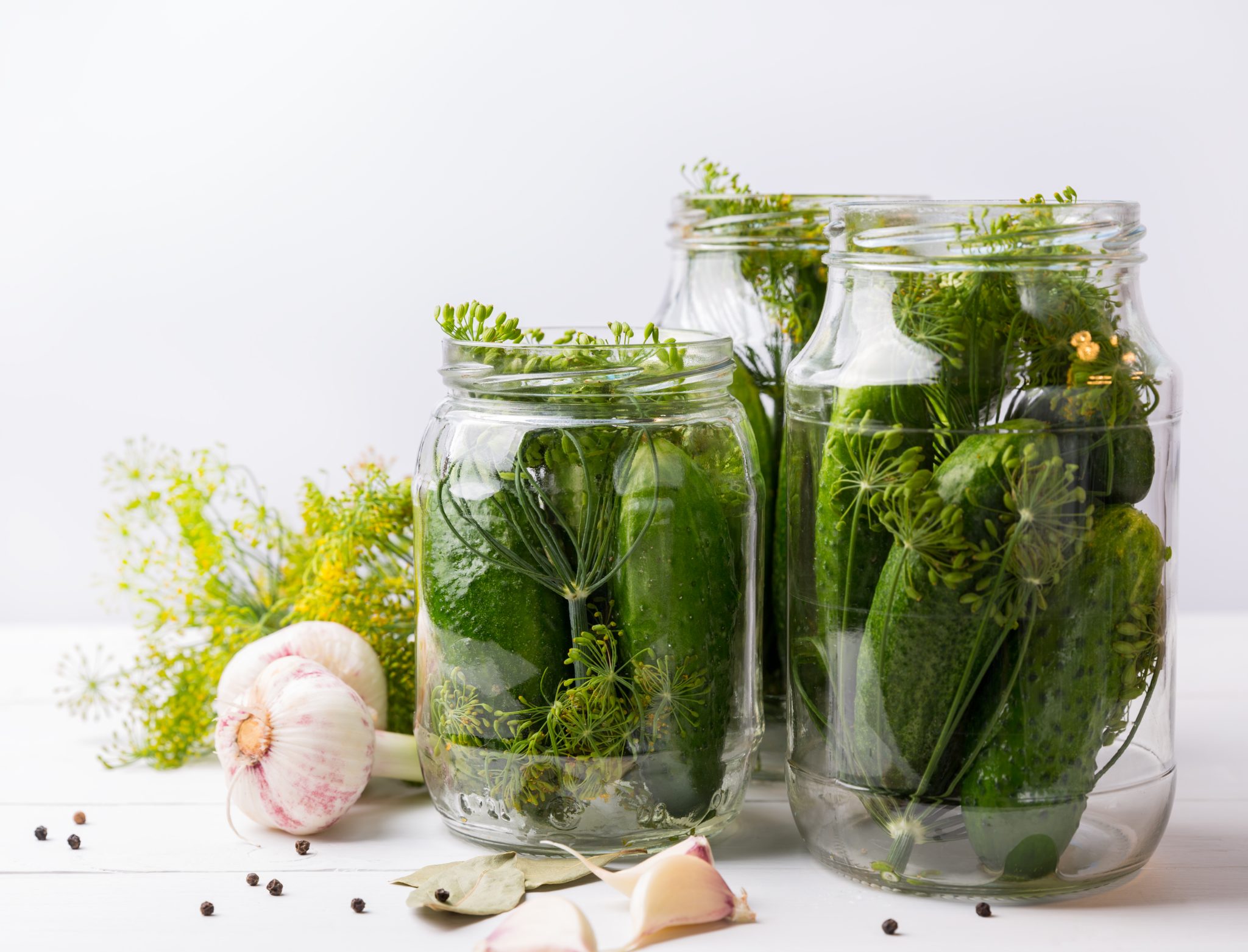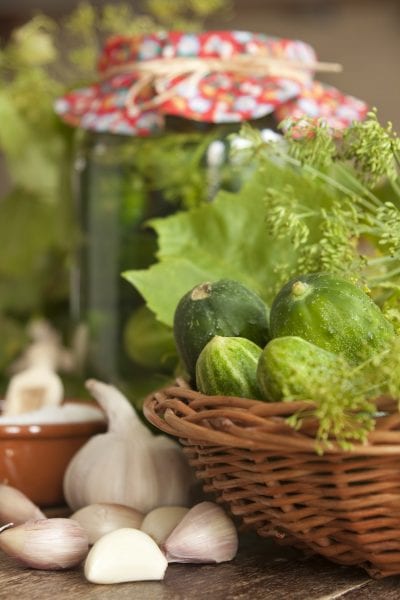Food Safety

Pickles add zip and zest to your meals, snacks, and party refreshments—if they are good pickles. They enhance the flavor of some foods that contain nutrients essential to good health.
Pickling is one of the oldest known methods of food preservation. The many varieties of pickled and fermented foods are classified by ingredients and methods of preparation. The four general classes are (1) brined or fermented, (2) fresh pack or quick process, (3) fruit pickles, and (4) relishes.
Caution
The level of acidity in a pickled product is as important to its safety as it is to the taste and texture.
Do not alter vinegar, food, or water proportions in a recipe or use a vinegar with unknown acidity. Acidity should be at least 5 percent.
Use only recipes with tested proportions of ingredients. Good sources are the United States Department of Agriculture (USDA) and the National Center for Home Food Preservation websites.
You must have a minimum, uniform level of acid throughout the mixed product to prevent the growth of botulinum bacteria.
Selecting Produce
Use only good-quality fruits and vegetables. Select tender vegetables and firm, ripe fruits. Pears and peaches may be slightly underripe for pickling.
A pickling-type cucumber makes a better pickle. Some varieties found to be good are Model, Chipper, Explorer, Carolina, Ashley, Poinsett, and Gherkin. Wax-coated cucumbers (bought from the vegetable counter) are not suitable for pickling.
Select cucumbers of uniform size that are best suited to the recipe being followed. Use cucumbers within 24 hours after gathering. If they are kept (even refrigerated) longer than 24 hours before the pickling process begins, you will have a poor-quality product. Always remove the blossom. It contains enzymes that will soften the cucumber. If whole cucumbers are to be brined, leave a 1⁄4-inch stem. Harvest cucumbers before they get too large for the best-quality product.
Salt
Pure granulated salt with no noncaking material or iodine added is best. Pickling salt, sea salt fine grain, and pink Himalayan fine grain salt can all be used and can be found with other salts at the grocery store or in the canning section. Iodine can cause pickles to darken, and noncaking material may prevent fermentation during the brining process and turn the brine cloudy. Refined table salt should not be used for brining cucumbers. Never use ice cream salt or rock salt for pickles.
Vinegar
Use a good-grade, 5 to 6 percent acid (40- to 60-grain strength). Cider (red) vinegar, used in most recipes, has a good flavor and aroma, but it may turn pickles brown. Distilled (white) vinegar is often used for onions and cauliflower when a clear color is desirable.
Spices
Tie whole spices in a thin cloth bag; remove them before pickles and relishes are packed. Whole spices, if left in the jar, will not only darken the pickles but also may cause some off-flavor. Ground spices tend to darken pickles. Be sure to use fresh spices—ground or whole. Store spices in a cool place (about 70 degrees F) in airtight containers. If a substitution in spices has to be made, a rule of thumb is 1⁄4 teaspoon dried = 3⁄4 to 1 teaspoon fresh. For dill, 1 head = 1 teaspoon dillseed.
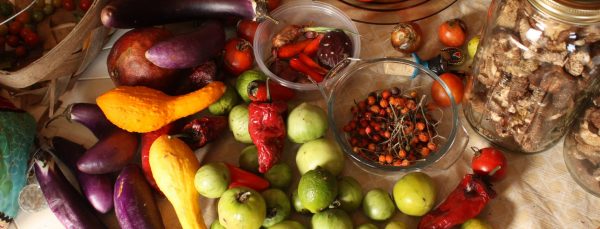
Sugar
Most recipes use white granulated sugar; however, some use brown sugar. If you plan to use a sugar substitute, follow recipes developed for these products. Sugar substitutes are not recommended in pickling because heat and/or storage may cause bitterness, and the sugar substitutes do not plump the pickles and keep them firm the way sugar does.
Firming Agents
The reason for soft pickles is sometimes simply not removing the blossom end of the cucumber. Slice off at least 1⁄4 inch on the end where the blossom was. The use of ice to firm pickled products is one great way to get a crunchy product. Soak produce in ice water for 4 to 5 hours before pickling.
Alum may be used safely to firm fermented pickles, but it is unnecessary. Some people have digestive issues with it. Alum does not improve the firmness of quick-processed pickles. The calcium in lime improves pickle firmness. Food-grade lime may be used as a lime-water solution for soaking fresh cucumbers before pickling them. Excess lime absorbed by the cucumbers must be removed to make safe pickles. Cucumbers or vegetables soaked in lime must be rinsed several times to remove the lime. To further improve pickle firmness, process cucumber pickles for 30 minutes in water at 180 degrees F. This process also prevents spoilage, but the water temperature should not fall below 180 degrees F. Use a candy or jelly thermometer to check the water temperature.
Hard Water
Do not use hard water from the tap. Boil hard water in a stainless steel or unchipped enamel boiler for 15 minutes and remove from heat. Cover and let sit for 24 hours. Remove any scum that may have formed. Slowly pour water from the container so sediment will not be disturbed. Discard sediment. Water is now ready to use.
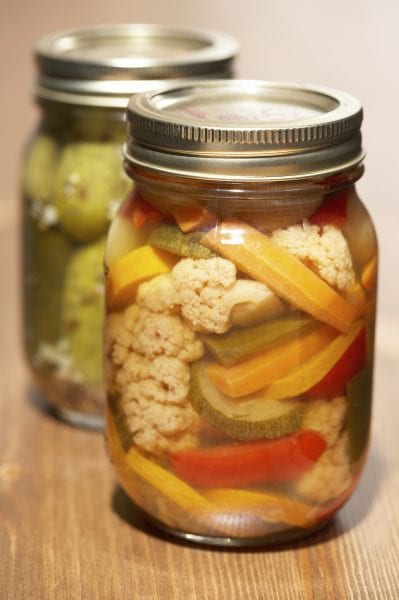
Equipment
For Pickling
For heating pickling liquids, use unchipped enamelware, stainless steel, aluminum, or glass pots. Do not use copper, brass, iron, or galvanized utensils. These metals may react with acids or salts and cause undesirable color and flavors, or they may even form toxic compounds in the pickle mixture.
For Brining or Fermenting
A 1-gallon container holds 5 pounds of fresh cucumbers and a 5-gallon container holds 25 pounds. Glass and food-grade plastic containers are excellent substitutes for stone crocks. Other 1- to 3-gallon food-grade containers may be used if lined inside with a clean food-grade plastic bag. Do not use garbage bags or trash liners. A large sealed food-grade plastic bag containing 41⁄2 tablespoons of salt and 3 quarts of water may be used as a weight to hold cucumbers under the surface of the brine. A plate and jars of water also may be used. Select a pie or dinner plate just small enough to fit inside the fermentation container. Cover the weight and container top with a heavy, clean bath towel to reduce mold growth on the brine surface.
Jars
Use standard canning jars. Wash and sterilize jars in boiling water; keep jars warm until they are filled. Use self-sealing lids with screw bands. Do not use lids or
jars from commercially canned foods. They are designed for use on special packing machines and are not suitable for reuse in home canning. Before sealing the filled jars, remove air bubbles. Do this by sliding a plastic spatula down each side of the jar. Be sure to cover pickles or relish with liquid. Wipe jar mouth with a clean, damp cloth. Adjust lids according to the manufacturer’s directions and then process in a water bath canner according to product processing time needed.
Pickle Problems and Their Causes
Soft, Slippery Pickles. (1) cucumbers exposed above the brine, (2) brine too weak, (3) cucumbers stored in too warm a place, (4) cucumbers precooked too long or at too high a temperature, (5) seal not airtight, (6) insufficient heat treatment, or (7) blossom left on cucumbers.
Shriveled Pickles. (1) cucumbers placed in very strong salt, sugar, or vinegar solution, (2) cucumbers overcooked, (3) pickles overprocessed, or (4) cucumbers gathered too long before pickling.
Hollow Pickles. (1) faulty development of cucumber, (2) excessive delay in placing them in brine, (3) too rapid fermentation, (4) high temperature during fermentation, or (5) brine too strong or too weak during fermentation.
Scum. Spoilage of top layer of cucumbers or cabbage fermented in brine is sure to occur unless scum is frequently removed. Scum is made up of wild yeast, molds, and bacteria that will attack and break down the structure of the cucumber or cabbage beneath. It may also weaken the acidity of the brine, thus causing spoilage.
Black Spots. (1) iodine in salt, or (2) iron in water.
Darkened Pickles. (1) hard water used, (2) ground spices used, (3) whole spices left in the jar, (4) pickles not covered with liquid, (5) iodized salt used, or (6) pickles stored in light that is too strong need to be in a dark, dry location.
Cloudy Pickles. (1) hard water used, (2) salt had noncaking agent, (3) storage temperature too warm, or (4) curing process ended before fermentation was completed.
White Sediment. In dill pickles, this sediment is generally harmless yeast that has grown on the surface and then settled.
Bitter Taste. Too much alum.
Purple or Green Garlic. Color change is caused by a reaction to the vinegar. It is not harmful.
Recipes
Brined Dill Pickles
20 pounds (about 1⁄2 bushel) cucumbers, 3 inches long
3/4 cup whole, mixed pickling spices
2 to 3 bunches fresh or dried dill
2 1/2 cups vinegar
1 3/4 cups pickling salt
2 1/2 gallons water
Cover cucumbers with cold water. Wash thoroughly, using a vegetable brush; handle gently to avoid bruising. Take care to remove any blossoms. Drain on rack or wipe dry.
Place half the pickling spices and a layer of dill in a 5-gallon crock or stone jar. Fill with cucumbers to 3 to 4 inches from top of crock. Place a layer of dill and remaining spices over the top of cucumbers. Garlic may be added if desired. Mix well the vinegar, salt, and water, and pour over the cucumbers.
Cover with a heavy china or glass plate or lid that fits inside the crock, and use weight, such as a full jar of water with a tight-fitting lid, on top of the cover to keep cucumbers under the brine. Cover loosely with a clean cloth. Keep pickles at room temperature, and remove scum daily when formed. Scum may start forming in 3 to 5 days. Do not stir pickles around in the jar, but be sure that they are completely covered with brine. If necessary, make additional brine, using original proportions.
In about 3 weeks, the cucumbers will have become an olive-green color and should have a desirable flavor. Any white spots inside the fermented cucumbers will be eliminated by processing.
The original brine is usually cloudy as a result of yeast development during the fermentation period. If this cloudiness is objectionable, fresh brine can be used to cover the pickles when packing them; make the brine with 1⁄2 cup salt, 4 cups vinegar, and 1 gallon water. The fermented brine, however, is generally preferred for added flavor, and it should be strained and heated to boiling.
Pack the pickles, along with some of the dill, into clean, hot standard jars; add garlic if desired. Avoid too tight a pack. Cover with boiling brine to 1⁄2 inch from the top of the jar. Wipe jar mouth. Adjust lid.
Put the jars on a rack in a canner containing boiling water; be sure the water comes 2 inches over jar tops. Cover canner tightly and start timing. Continue boiling and process for 15 minutes.
Remove jars from canner immediately when processing time is up, and set jars on a wire rack several inches apart to cool. Complete the seals if closures are not the self-sealing type.
- Yield: 9 to 10 quarts
Fresh-Packed Dill Pickles
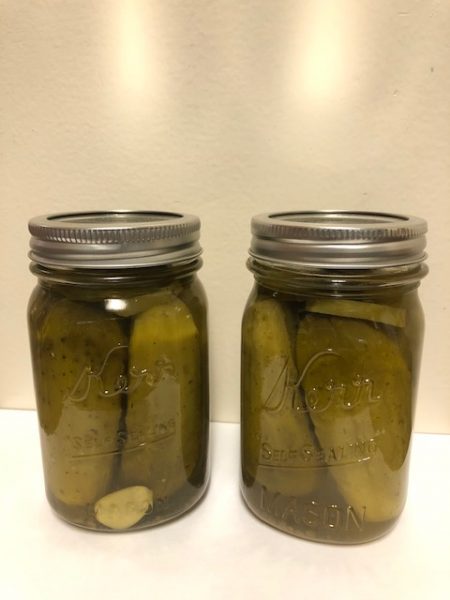 17 pounds cucumbers, 3 to 5 inches long
17 pounds cucumbers, 3 to 5 inches long
2 gallons water
1 1/2 cups pickling salt
6 cups cider vinegar
3/4 cup pickling salt
1/4 cup sugar
9 cups water
2 tablespoons whole, mixed pickling spices
14 teaspoons whole mustard seed
7 to 14 cloves garlic
21 heads fresh or dried dill plant (or 7 tablespoons dillseed)
Wash cucumbers thoroughly; scrub with vegetable brush and drain. Thoroughly mix 2 gallons of water and 1 1⁄2 cups salt. Cover cucumbers. Let sit overnight; drain.
Combine vinegar, salt, sugar, and water. Tie mixed pickling spices in a thin, white cloth. Add to vinegar mixture, and heat to boiling. Pack 7 to 10 cucumbers into each clean, hot, quart-size standard canning jar. Add to each quart jar 2 teaspoons whole mustard seed, 1 or 2 cloves of garlic, and 3 heads of dill plant (or 1 tablespoon dillseed). Cover with boiling liquid to within 1⁄2 inch of top of the jar. Wipe jar mouth. Adjust lid. Process in boiling waterbath canner (212 degrees F) for 20 minutes. (Start counting the processing time as soon as the hot jars are placed in the actively boiling water.)
- Yield: 7 quarts
Crosscut Pickle Slices
4 quarts sliced, medium-size cucumbers (about 6 pounds)
1 1/2 cups sliced small white onions (12 to 15, about 1 pound)
2 large garlic cloves
2 quarts crushed ice or 2 trays ice cubes
1/3 cup pickling salt
4 1/2 cups sugar
1 1/2 teaspoons turmeric
3 cups white vinegar
1 1/2 teaspoons celery seed
2 tablespoons mustard seed
Wash cucumbers thoroughly, using a vegetable brush; drain on rack. Slice unpeeled cucumbers into 1⁄8- to 1⁄4-inch slices. Add sliced onions and garlic.
Add salt and mix thoroughly. Cover with crushed ice or ice cubes, and allow to stand for 3 hours. Drain thoroughly; remove garlic.
Combine sugar, spices, and vinegar; heat just to a boil. Add cucumber and onion slices, and heat 5 minutes.
Pack loosely into clean, hot standard pint-size jars. Leave 1⁄2-inch headspace. Wipe jar mouth. Adjust lid. Process in boiling waterbath (212 degrees F) for 5 minutes. (Start to count processing time as soon as water in canner returns to boiling.)
- Yield: 7 pints
Crisp Cucumber Pickles
7 pounds sliced cucumbers
2 gallons water
3 cups slaked lime
5 pounds sugar
5 pints distilled vinegar
1 teaspoon ground cinnamon
1 teaspoon ground cloves
1 teaspoon ground allspice
1 teaspoon celery seed
Select small cucumbers (about 11⁄4-inch diameter); wash, and slice about 1⁄8-inch thick. Mix 2 gallons water with 3 cups slaked lime. Pour over cucumbers, and cover. Let stand at room temperature for 24 hours. Stir several times during this period. Drain and cover cucumbers with water. Change water each hour for 4 hours. Drain well. Make syrup of vinegar, sugar, and spices; bring to a boil, and pour over cucumbers; let stand overnight. Next morning, heat cucumbers and syrup to a boil, and let simmer about 1 hour. Pack into hot standard canning jars. Leave 1⁄2-inch headspace. Wipe jar mouth, and adjust lid. Process in boiling waterbath canner (212 degrees F) for 10 minutes.
- Yield: about 16 pints
Crunchy Cucumber Sticks
7 pounds large cucumbers
2 1/2 cups slaked lime
2 gallons water
4 ounces alum
2 gallons water
2 quarts distilled vinegar
1 quart water
1 tablespoon pickling salt
2 tablespoons mixed, whole pickling spices
5 pounds sugar
First Day at 7 p.m. Begin the process. Use 7 pounds of very large cucumbers that have been peeled, seeded, and cut into sticks. Soak cucumbers in lime water for 24 hours. Use 2 1⁄2 cups slaked lime in 2 gallons of water.
Second Day at 7:00 p.m. Take cucumbers out of lime water. Wash in clear water. Soak in alum water for 12 hours. Use 4 ounces of alum in 2 gallons of water.
Third Day at 7:00 a.m. Remove cucumbers from the alum water. Soak in clear water for 6 hours.
Make a syrup of the last five ingredients. Bring syrup to a boil and pour over well-drained cucumbers. Let stand 4 hours. Bring to a boil, and cook slowly until pickles are transparent or clear, about 30 minutes. Remove spices. Pack into standard canning jars. Wipe jar mouth. Adjust lid. Process in boiling waterbath canner (212 degrees F) for 10 minutes.
- Yield: 11 pints
Dilled Green Tomato Pickles
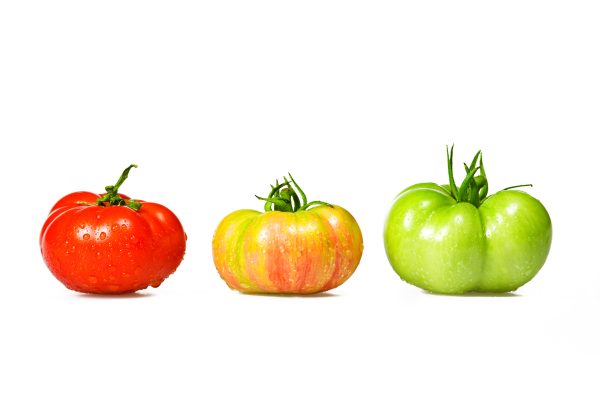 10 pounds green tomatoes
10 pounds green tomatoes
Garlic
Stalk celery
Sweet green peppers
2 quarts water
1 quart cider vinegar
1 cup pickling salt
Dill to taste
Use small, firm, green tomatoes. Wash. Pack into clean, standard canning jars. Add to each pint jar a clove of garlic, a 3-inch stalk of celery, and a wedge of green pepper. Mix the water, vinegar, salt, and dill. Boil for 5 minutes. Pour the hot mixture over the tomatoes in the jars, leaving 1⁄2 inch headspace. Wipe jar mouth, and adjust lid. Process in boiling waterbath canner (212 degrees F) for 15 minutes. Pickles will be ready to use in 4 to 6 weeks.
- Yield: 10 to 12 pints
Green Tomato Iceberg Pickles
10 pounds sliced green tomatoes
1 cup slaked lime
4 tablespoon powdered alum
1 tablespoon baking soda
1⁄2 cup ginger root
10 pounds sugar
1 gallon cider vinegar
2 teaspoons whole allspice
1 teaspoon whole cloves
1 teaspoon mace chips
Select good, firm, green tomatoes about 2 inches in diameter. Wash and slice tomatoes 1⁄4-inch thick.
Soak 10 pounds of sliced tomatoes for 3 days in 1 cup slaked lime to 1 gallon water, and store in a cool place, preferably in a refrigerator. Drain and soak for 3 days in 1 gallon water to which 2 tablespoons of powdered alum have been added, and store in refrigerator. Wash tomatoes in clear water. Drain, and bring to a boil in fresh alum water (2 tablespoons alum and 1 gallon water). While boiling hard, remove tomatoes from range, and set vessel in sink. Add 1 tablespoon soda to tomatoes (mixture may run over after the soda has mixed well). Drain. Boil tomatoes for 5 minutes in strong ginger tea (1⁄2 cup ginger root in 1 gallon water for 10 pounds of tomatoes). Drain. Add 1 pound of sugar to 1 pound of fruit; cover well with cider vinegar. For each gallon of vinegar used, add 2 teaspoons whole allspice, 1 teaspoon whole cloves, and 1 teaspoon mace chips (tie spices in a thin cloth bag). Let boil slowly until vinegar is thick. Pack in standard canning jars; cover with liquid. Wipe jar mouth. Adjust lid. Process in a boiling waterbath canner (212 degrees F) for 10 minutes.
- Yield: about 12 pints
Quick-Method Pickled Peaches
5 quarts peeled peaches
6 1⁄2 cups sugar
1 quart cider vinegar
1 1⁄4 teaspoons mixed pickling spices 10 cloves
5 small pieces of stick cinnamon
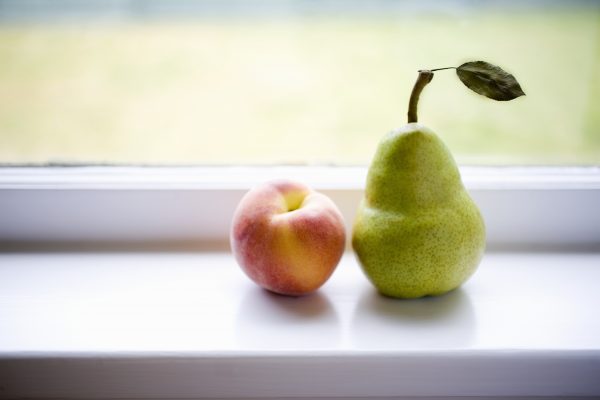 Use firm, ripe peaches suitable for pickling—Hiland, Cardinal, Red Haven, Dixie Red, Cornet, Redcap, etc. Make syrup of 61⁄2 cups sugar and 1 quart cider vinegar. Heat syrup, and add peeled peaches. Let fruit and syrup simmer for 10 minutes. To each quart-size standard canning jar, add 1⁄4 teaspoon mixed pickling spices, 2 cloves, and 1 small piece of stick cinnamon. Add hot fruit to the jar; cover with hot syrup and adjust the lid. Process in boiling waterbath canner (212 degrees F) for 25 minutes. Let peaches “season” at least 1 week. Wait 6 weeks for peaches to develop their best flavor.
Use firm, ripe peaches suitable for pickling—Hiland, Cardinal, Red Haven, Dixie Red, Cornet, Redcap, etc. Make syrup of 61⁄2 cups sugar and 1 quart cider vinegar. Heat syrup, and add peeled peaches. Let fruit and syrup simmer for 10 minutes. To each quart-size standard canning jar, add 1⁄4 teaspoon mixed pickling spices, 2 cloves, and 1 small piece of stick cinnamon. Add hot fruit to the jar; cover with hot syrup and adjust the lid. Process in boiling waterbath canner (212 degrees F) for 25 minutes. Let peaches “season” at least 1 week. Wait 6 weeks for peaches to develop their best flavor.
- Yield: 5 quarts
Pear Pickles
4 quart pears (peeled, cored, and cut in halves or quarters)
1 pint water
2 tablespoons whole allspice
2 1⁄2 sticks cinnamon
2 quarts sugar
1 quart cider vinegar
Boil pears in a covered vessel in 1 pint water for 10 minutes. Tie spices loosely in a thin cloth bag. Combine the water the pears were cooked in, sugar, vinegar, and spices, and heat to boiling. Pour over pears, and let stand overnight in covered vessel. Drain, and boil syrup until thick. Add pears and cook until tender. Do not stir, but keep pears under syrup. Pack into hot standard canning jars, and cover with syrup. Wipe jar mouth, and adjust lid. Process in a boiling waterbath canner (212 degrees F) for 10 minutes.
- Yield: about 8 pints
If you use Kieffer pears, you will get the best results by gathering pears when about they are two-thirds to three-quarters mature. The best stage is when the green in immature fruit gradually fades and the fruit becomes lighter or slightly yellow. Spread out—one layer deep— in a cool (about 60 to 65 degrees F), dry place for about 2 weeks. The pears will have better flavor and texture. Then proceed according to the recipe.
Dilled Green Beans
4 pounds whole green beans
1 3⁄4 teaspoons crushed hot red pepper
3 1⁄2 teaspoons whole mustard seed
3 1⁄2 teaspoons dillseed
7 cloves garlic
5 cups cider vinegar
5 cups water
1⁄2 cup pickling salt
Wash beans thoroughly; drain and cut into lengths to fill pint-size standard canning jars. Pack beans into clean, hot jars, and add to each pint jar 1⁄4 teaspoon crushed hot red pepper, 1⁄2 teaspoon whole mustard seed, 1⁄2 teaspoon dillseed, and 1 clove garlic. Combine vinegar, water, and salt; heat to boiling. Pour boiling liquid over beans, filling to 1⁄2 inch from top of jar. Wipe jar mouth. Adjust jar lid. Process in boiling waterbath canner (212 degrees F) for 5 minutes.
- Yield: 7 pints
Green Tomato Mincemeat
1 teaspoon whole allspice
1 teaspoon whole cloves
1 1⁄2 pint finely chopped, peeled tart apples
1 pint finely chopped green tomatoes
1 teaspoon pickling salt
2 teaspoons ground cinnamon
3 cups canning sugar
1 pound seedless raisins
1⁄4 cup cider vinegar
1 cup ground suet (optional)
Tie allspice and cloves in a thin cloth bag. Mix all ingredients; bring to rapid boil and simmer until thick. Pour into clean, standard canning jars to within 1 inch of top. Wipe jar mouth, and adjust lid. Process in boiling waterbath canner (212 degrees F) for 25 minutes.
- Yield: 3 pints
NOTE: This is good to serve with meats, as a topping for ice cream, or as pie filling.
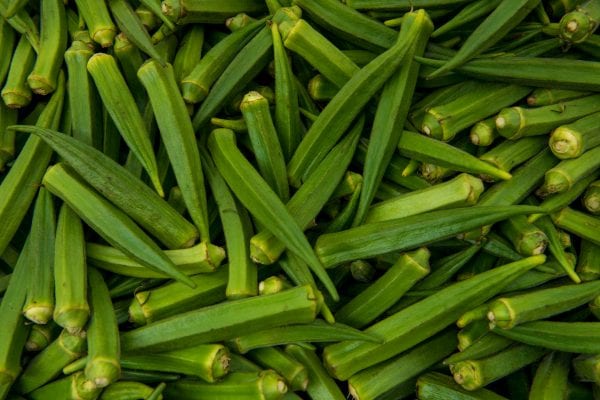
Pickled Okra
2 pints small okra (2 to 3 inches long; leave 1⁄4-inch stem)
1 cup cider vinegar
1⁄4 cup water
2 tablespoons pickling salt
2 teaspoons dillseed
4 garlic cloves
2 pods hot pepper
Boil pint-size standard canning jars for 15 minutes. Wash okra, using a vegetable brush. Bring the vinegar, water, and salt to a boil. Remove hot jars, and place washed okra in each jar. Add to each pint jar 1 teaspoon dillseed, 2 garlic cloves, and 1 pod of hot pepper. Pour boiling liquid mixture into each jar, covering okra. Leave 1⁄2-inch headspace. Wipe jar mouth. Adjust lid. Process in boiling waterbath canner (212 degrees F) for 5 minutes. Pickled okra will be ready to use in 4 to 6 weeks.
- Yield: 2 pints
IMPORTANT: If there is any sign of spoilage, discoloration, odor, etc., burn the contents. Clostridium botulinum, a very poisonous bacterium, is present in vegetables. These bacteria are generally destroyed at 10 pounds pressure for a given time; however, this recipe does not use pressure as a method of preserving. These bacteria do not readily live in an acid liquid, but it is possible. Therefore, it is extremely important that this pickled okra be given special care.
Bread and Butter Squash Pickles
8 cups thinly sliced yellow summer squash
2 cups thinly sliced white onions
2 tablespoons pickling salt (not iodized)
2 1⁄2 cups cider vinegar
3 cups sugar
2 teaspoons celery seed
2 teaspoons mustard seed
4 sweet bell peppers, thinly sliced
Combine squash and onions. Sprinkle with salt. Set aside for 1 hour. Drain off liquid. Combine vinegar, sugar, celery seed, mustard seed, and pepper. Bring to a hard boil. Add squash mixture. Bring to a boil. Pack into hot, pint-size standard canning jars. Adjust lids and bands. Process in boiling waterbath canner (212 degrees F) for 5 minutes.
- Yield: about 6 pints
Cucumber Relish
2 quarts chopped cucumbers
2 cups chopped sweet green peppers
2 cups chopped sweet red peppers
1 cup chopped onion
1 tablespoon turmeric
1⁄2 cup pickling salt
2 quarts cold water
1 tablespoon mustard seed
2 teaspoons whole allspice
2 teaspoons whole cloves
2 sticks cinnamon
1 quart vinegar
1 1⁄2 cups brown sugar, packed
Combine cucumbers, peppers, onions, and turmeric. Dissolve salt in cold water, and pour over vegetables. Let stand 3 to 4 hours. Drain. Cover vegetables with cold water, and let stand 1 hour. Drain thoroughly.
Tie spices in a thin cloth bag. Add to vinegar and brown sugar. Heat to boiling, and pour over vegetables. Cover and let stand 18 to 24 hours in a cool place.
Simmer vegetables until they are hot; then bring to a boil. Pack into hot, standard canning jars while still very hot. Leave 1⁄2-inch headspace. Wipe jar mouth and adjust lid. Process in a boiling waterbath canner (212 degrees F) for 10 minutes.
- Yield: about 6 pints
Corn Relish
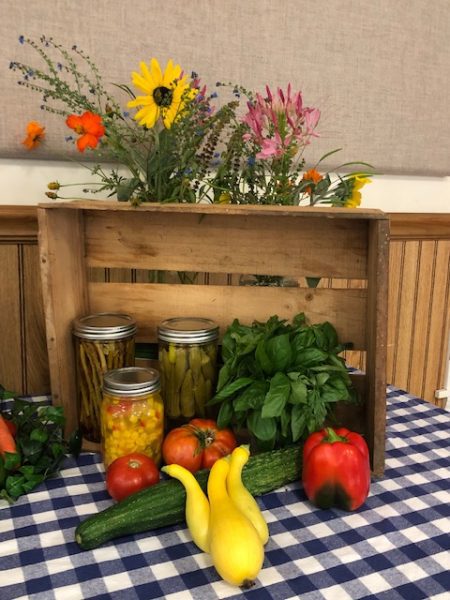 2 quarts corn (use 16 to 20 fresh medium-size ears or 6 10-ounce. packages frozen whole kernel)
2 quarts corn (use 16 to 20 fresh medium-size ears or 6 10-ounce. packages frozen whole kernel)
1 pint diced sweet red peppers (4 to 5 medium)
1 pint diced sweet green peppers (4 to 5 medium)
1 quart chopped celery (1 large bunch)
1 cup finely chopped or thinly sliced onions (8 to 10 small, 3⁄4 pound)
1 1⁄2 cups sugar
1 quart cider vinegar
2 teaspoons pickling salt
2 teaspoons celery seed
2 tablespoons dry mustard, powdered 1 teaspoon turmeric
1⁄4 cup flour
1⁄2 cup water
Fresh Corn. Remove husks and silk. Cook ears of corn in boiling water for 5 minutes; remove and plunge into cold water. Drain; cut, whole grain style, from cob. Do not scrape cob.
Frozen Corn. Defrost overnight in refrigerator or for 1 hour at room temperature. Place closed containers in front of a fan to hasten defrosting. Combine peppers, celery, onions, sugar, vinegar, salt, and celery seed. Cover pan until mixture starts to boil; boil uncovered for 5 minutes, stirring occasionally.
Mix dry mustard, turmeric, flour, and water. Blend with liquid from boiling mixture; add corn. Return to boiling and cook for 5 minutes. Frequent stirring will be necessary to prevent sticking and scorching.
Pack loosely while still very hot into hot, standard pint- size jars, filling to 1⁄2 inch from top. Wipe jar mouth. Adjust lid. Process in boiling waterbath (212 degrees F) for 15 minutes. Remove jars and complete seals if closures are not self-sealing.
- Yield: 7 pints
For best results with pickled products, wait a few weeks for flavors to blend, and then serve cold.
 Revised by Angela Treadaway, Regional Extension Agent, Food Safety and Quality, Auburn University. Written by Evelyn F. Crayton, former Extension Foods and Nutrition Specialist; and Isabelle Downey, former Home Economist–Food Preservation. Reference: “Making Pickles and Relishes at Home,” USDA Home and Garden Bulletin No. 92.
Revised by Angela Treadaway, Regional Extension Agent, Food Safety and Quality, Auburn University. Written by Evelyn F. Crayton, former Extension Foods and Nutrition Specialist; and Isabelle Downey, former Home Economist–Food Preservation. Reference: “Making Pickles and Relishes at Home,” USDA Home and Garden Bulletin No. 92.
Revised March 2022, Pickling Produce, HE-0071

